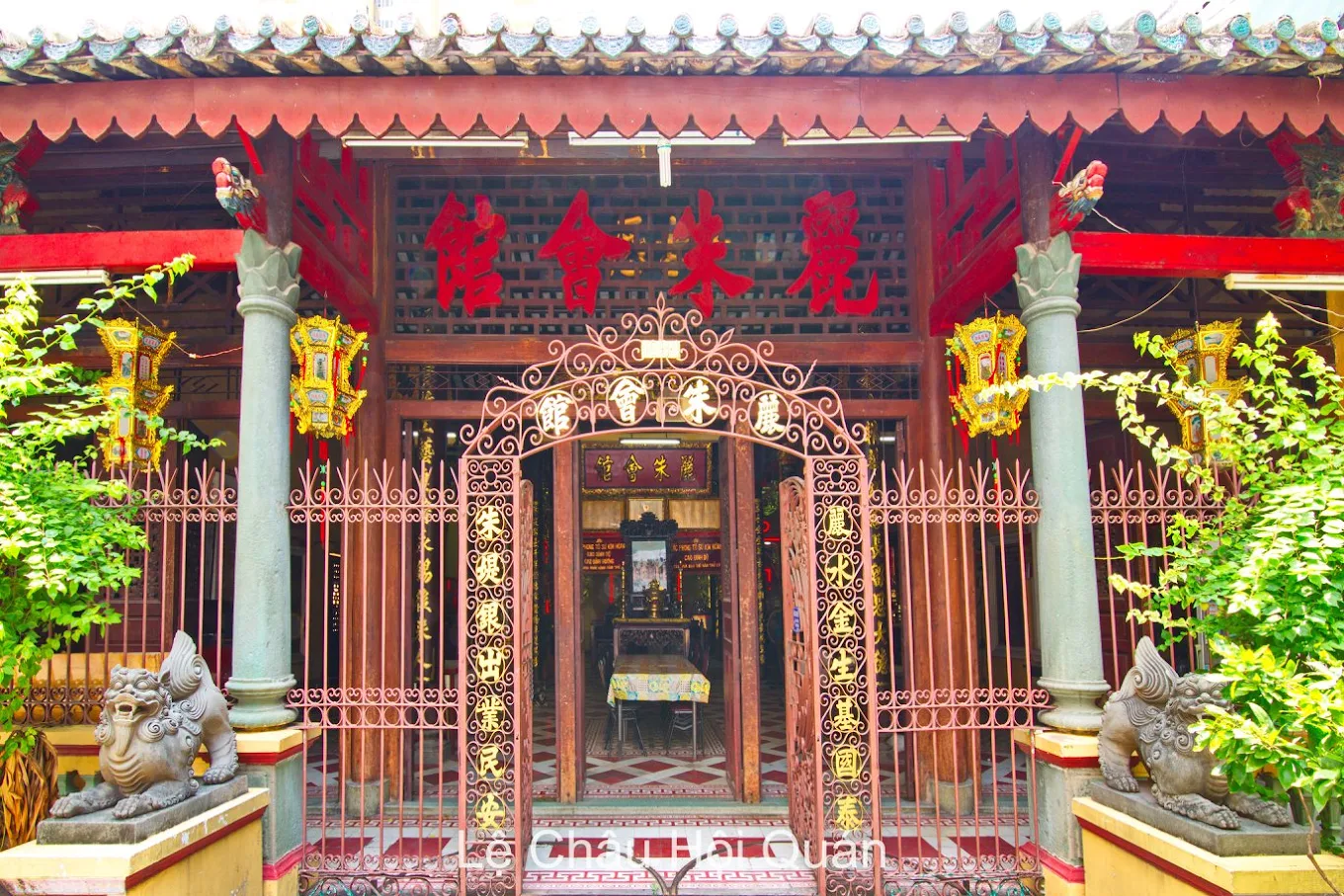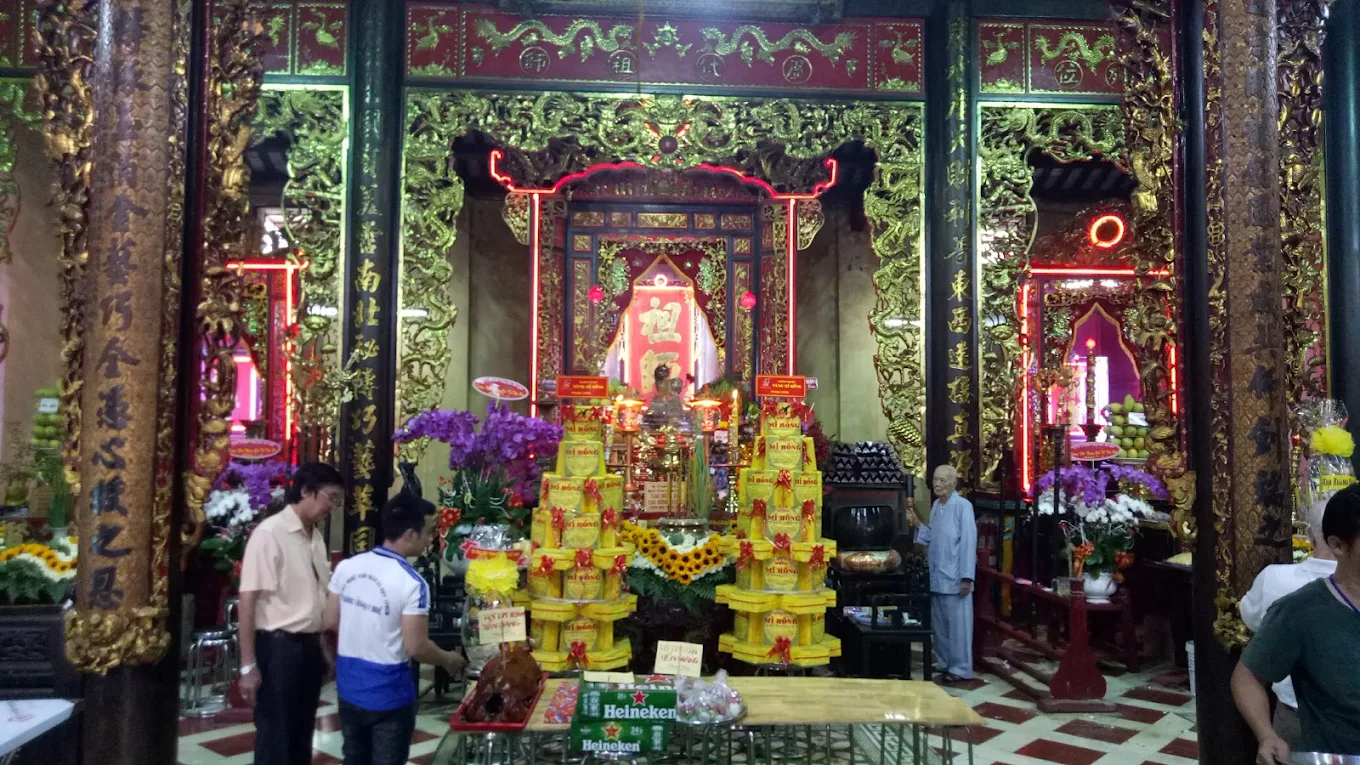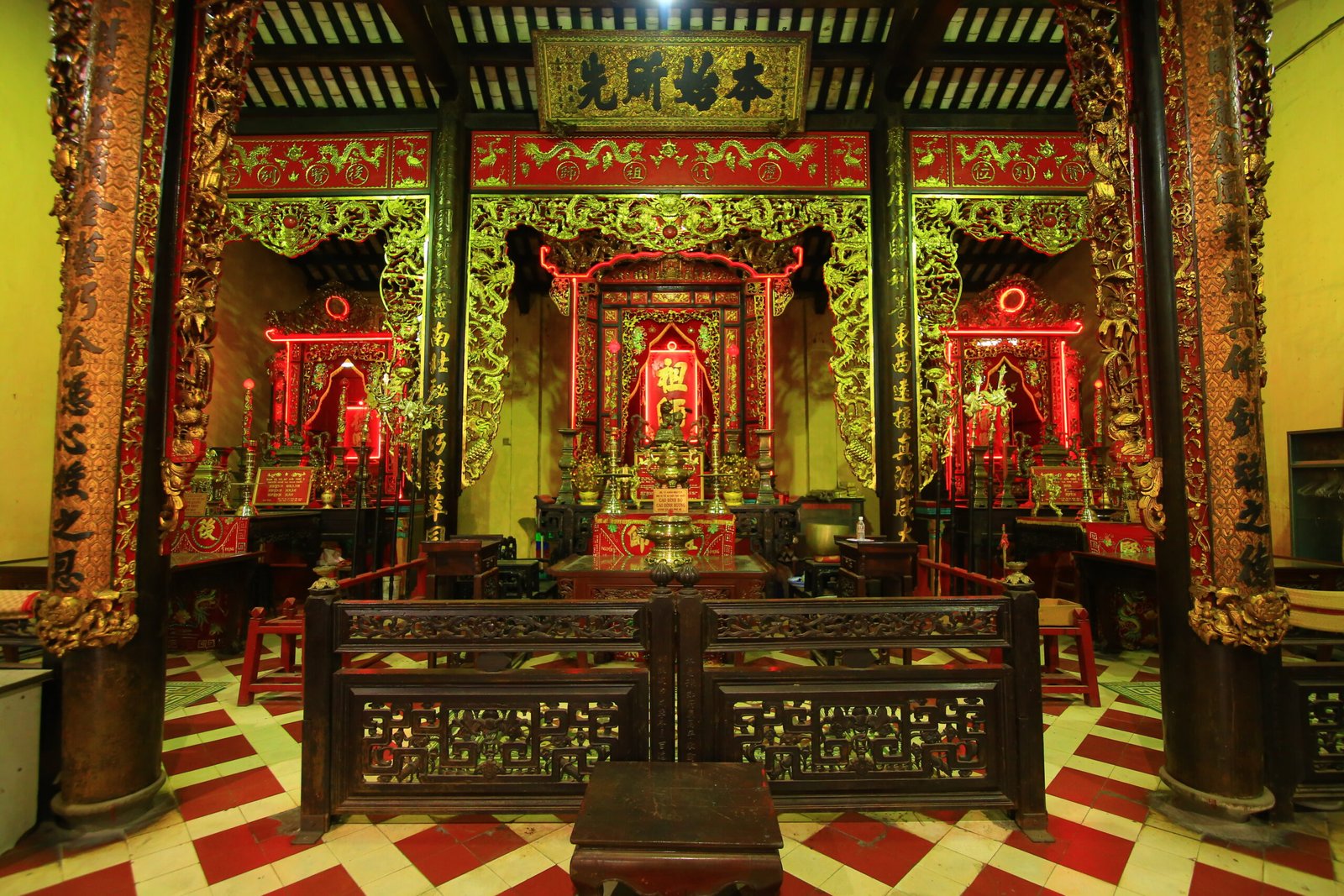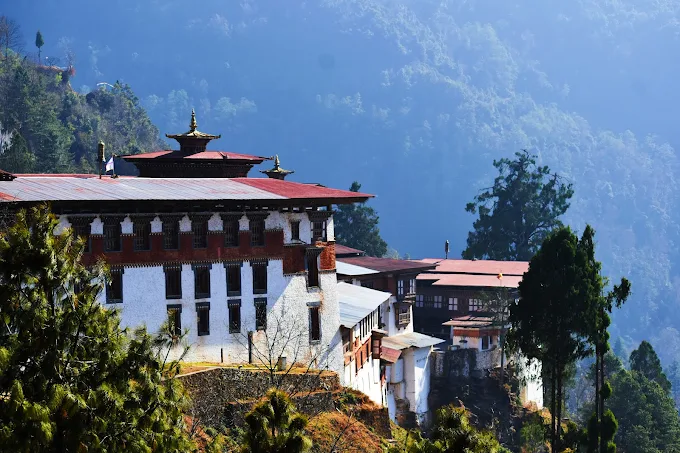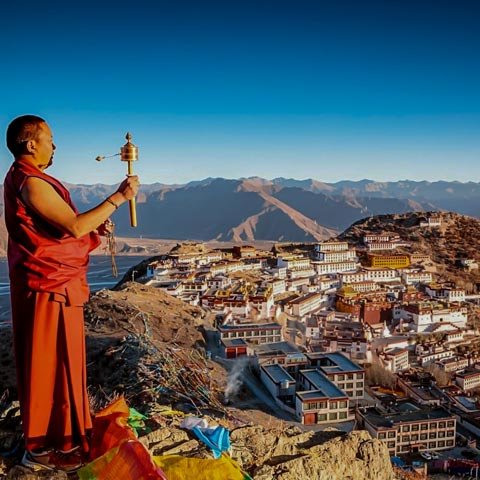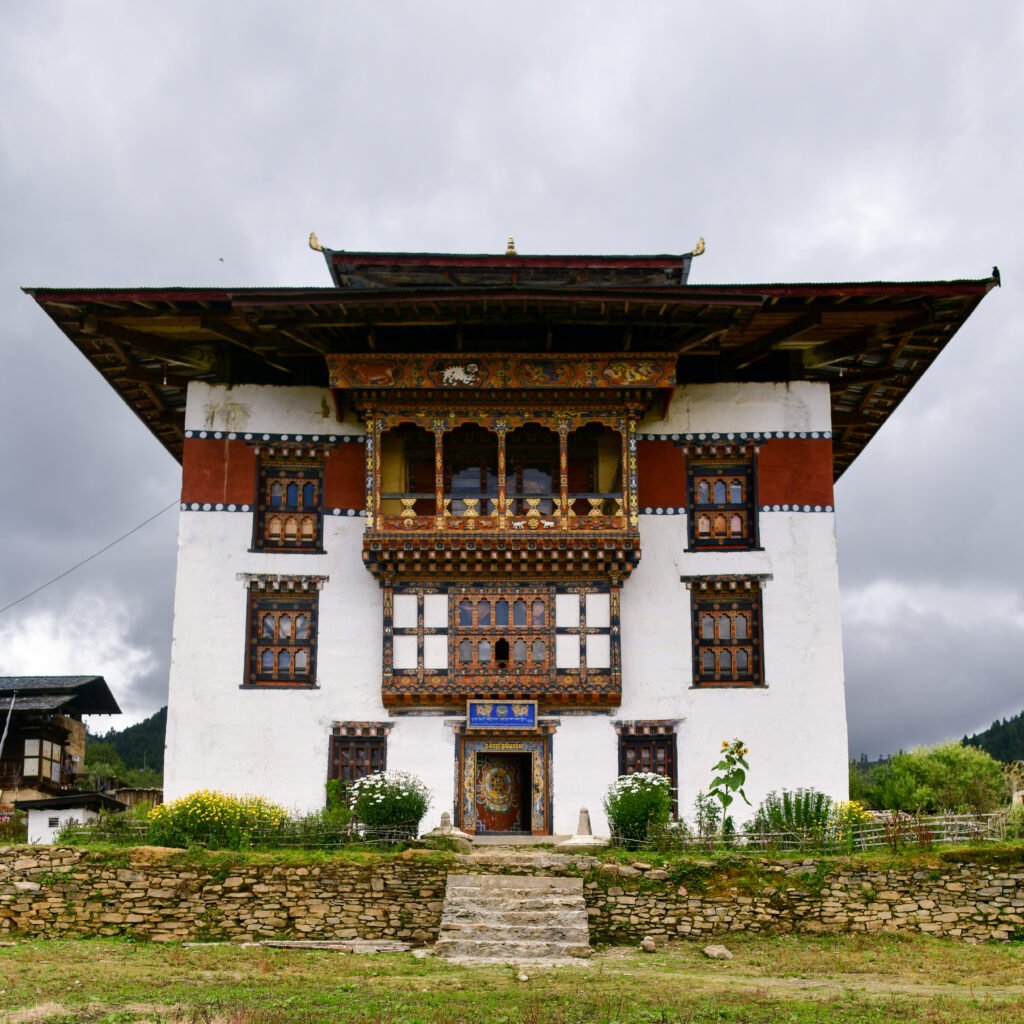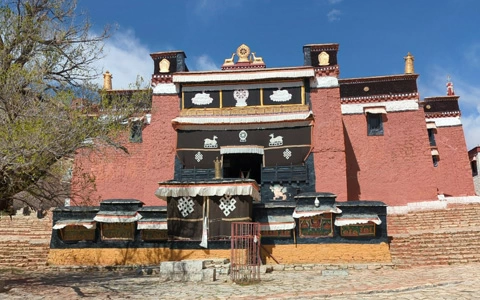Lệ Châu Pagoda: A Sacred Haven of Teochew Craftsmanship in Chợ Lớn
At 586 Trần Hưng Đạo Street in Chợ Lớn’s vibrant heart, Lệ Châu Pagoda [Lệ Châu Hội Quán] stands as a sacred haven, its curved roof and glowing incense enveloping the Patron of Silversmiths’ altar in Teochew devotion. Monks arrange roasted pig offerings before the altar, while red lanterns cast a warm glow over intricate ceramic carvings. The gentle hum of a 19th-century incense burner blends with prayers, creating a peaceful retreat amid Ho Chi Minh City’s bustling District 5. Built around 1905 by immigrants from Chaozhou, Guangdong, China, this pagoda weaves Teochew artistry with Buddhist spirituality, inviting visitors to explore Lệ Châu Pagoda’s rich heritage.
Overview and Significance
Introduction to Lệ Châu Pagoda
Lệ Châu Pagoda, also known as Hội Quán Lệ Châu, is a cornerstone of Northern Mahayana Buddhism and Teochew Chinese culture in District 5, Ho Chi Minh City, celebrated for its devotion to the Patron of Silversmiths [Tổ Sư Kim Hoàn], a deified figure revered as the guardian of artisans and prosperity. Founded around 1905 by immigrants from Chaozhou, a city in Guangdong Province, China, renowned for its maritime trade and distinct Teochew culture, the pagoda served as a community hall for silversmiths and merchants, reflecting the Teochew diaspora’s craftsmanship and heritage. Northern Mahayana, emphasizing compassion and enlightenment, blends with Taoist and Teochew folk beliefs, creating a unique spiritual tapestry. Spanning 1,000 square meters with a 300-square-meter courtyard, the pagoda attracts devotees and tourists for prayer, festivals, and cultural exploration, its red-and-green Teochew design a hallmark of East Asian artistry. Lệ Châu Pagoda anchors Chợ Lớn’s cultural identity, inviting visitors to immerse in its traditions.
The pagoda’s significance lies in its role as a spiritual and community hub for the Teochew community, fostering unity through rituals like roasted pig offerings [heo quay] and festivals such as the Lantern Festival [Tết Nguyên Tiêu], which celebrates renewal with vibrant lantern displays. Its main hall [chánh điện], adorned with carved wooden screens [bao lam] and horizontal inscribed boards [hoành phi], showcases centuries of craftsmanship, while its charity, like rice distributions, strengthens its social impact. The courtyard’s stone lions, designed for feng shui [phong thủy], a traditional Chinese practice harmonizing individuals with their environment by balancing energies through spatial arrangement and natural elements, offer a serene space for reflection. Lệ Châu Pagoda’s blend of history, spirituality, and artistry makes it a must-visit for those seeking to explore Lệ Châu Pagoda history, connecting Teochew heritage with Vietnam’s vibrant present.
Historical Journey
Lệ Châu Pagoda’s story began around 1905, when Teochew immigrants from Chaozhou, Guangdong, China, built it as a community hall in Chợ Lớn, near Bình Tây Market, to support silversmiths and merchants. Constructed with wooden beams, stone pillars, and green-glazed tiles, it honored the Patron of Silversmiths, reflecting Chaozhou’s artisanal traditions. A 19th-century stone tablet records donations from Teochew craftsmen, highlighting early unity, as noted in local records.
Renovations in 1920, 1937, and 1954 preserved its Teochew architecture, with the 1920 renovation adding ceramic carvings [khắc gốm] like Two Dragons Chasing the Pearl [Lưỡng Long Tranh Châu]. During the 1960s and 1970s, monks hid relics, including a 19th-century bronze incense burner [lư hương], to protect them during wartime. The 1954 renovation, funded by community donations, restored the pagoda’s vibrant colors and reinforced its structure, cementing its role as a cultural landmark. Today, the management board oversees charity and cultural activities, keeping the pagoda a spiritual anchor in District 5.
This journey reflects the Teochew community’s resilience, from establishing a new home in Vietnam to safeguarding their heritage. The 1937 renovation added stone lions, enhancing the courtyard’s protective symbolism, while 1954 restored the roof’s ceramic carvings. Each effort preserved the pagoda’s Teochew identity, making it a beacon for those seeking to explore Lệ Châu Pagoda history and Chợ Lớn’s multicultural past.
Cultural Significance
Lệ Châu Pagoda is a spiritual haven in District 5, offering peace amid the lively Bình Tây Market, where vendors’ calls fade into the temple’s calm. Its daily prayers to the Patron of Silversmiths, rooted in Northern Mahayana Buddhism and Teochew Taoist traditions, draw devotees seeking blessings for craftsmanship and prosperity. The pagoda’s festivals, like the Lantern Festival, with vibrant lantern displays; the Vu Lan Festival [Lễ Vu Lan], honoring ancestors with offerings of rice and flowers; and the Hungry Ghost Festival [Cúng Cô Hồn], offering food and incense to wandering spirits, attract thousands from Ho Chi Minh City and beyond. These events unite communities, reflecting Vietnam’s spiritual values.
The pagoda’s unique devotion to the Patron of Silversmiths, tied to Teochew artisanal traditions, sets it apart in Chợ Lớn, as noted in local guides. Its ceramic carvings and calligraphic boards influence the area’s cultural identity, drawing scholars and tourists to explore Lệ Châu Pagoda’s heritage. Its charity, like rice distributions for District 5’s poor, embeds it in the community, making it a key destination for those seeking to discover its traditions. The pagoda’s serene green hues, a hallmark of Teochew architecture, enhance its allure, creating a tranquil presence in Chợ Lớn.
Unique Legacy
Lệ Châu Pagoda’s legacy blends spirituality, artistry, and resilience:
- Patron of Silversmiths Worship: His altar symbolizes craftsmanship and prosperity, drawing devotees for skill and success, a Teochew tradition.
- Community Resilience: Over 120 years, community-funded renovations preserved its heritage, cementing its cultural landmark status.
- Teochew Artistry: Ceramic carvings and calligraphic boards, blending Chinese and Vietnamese styles, set a cultural standard in Chợ Lớn.
This legacy captivates visitors seeking to explore Lệ Châu Pagoda history, making it a cultural beacon in District 5.
Community and Global Impact
Lệ Châu Pagoda fosters community ties in District 5, hosting daily prayers and monthly gatherings that unite Teochew and Vietnamese devotees. During the Lantern Festival and Hungry Ghost Festival, diaspora from Malaysia and Singapore join to offer incense, strengthening global ties. Its architecture and charity draw scholars, elevating its profile for those seeking to discover Lệ Châu Pagoda. Charity initiatives, like rice distributions, make it a vital hub for local and global communities, uniting diverse groups through shared faith and cultural pride.
Historical Anecdotes
- Teochew Craftsmanship: Teochew immigrants built the pagoda around 1905 to honor the Patron of Silversmiths, reflecting their artisanal traditions, as shared by the management board.
- 1920 Donation: A stone tablet records merchant contributions for the first major renovation, symbolizing unity.
- Wartime Preservation: Monks hid relics, like a 19th-century incense burner, during the 1960s–1970s, safeguarding heritage.
These stories enrich Lệ Châu Pagoda history, captivating visitors.
Social Role
The pagoda hosts charity events, like rice distributions during festivals, aiding District 5 families. Monthly gatherings foster mindfulness, while festivals like the Lantern Festival strengthen ties, making it a center for those seeking to immerse in Lệ Châu Pagoda traditions. Its role as a spiritual hub for Teochew devotees reinforces its social significance.
Artistic Influence
Ceramic carvings and calligraphic boards inspire Chợ Lớn artisans, influencing temple designs. Art exhibitions feature the pagoda’s carved wooden screens, showcasing Lệ Châu Pagoda architecture’s impact. Its Teochew aesthetics, with serene green hues, draw artists and visitors to explore its heritage, perpetuating its influence through local crafts.
The pagoda’s history and culture flow into its architecture, blending spirituality and artistry into a sacred space.
Architectural and Spiritual Features
Iconic Design
Lệ Châu Pagoda’s Quốc-shaped layout [chữ Quốc], a Chinese design with three parallel buildings forming a rectangular enclosure, spans 1,000 square meters, fostering harmony in temple design with a Teochew style from Chaozhou, Guangdong, China. Its green and red tiles contrast with District 5’s bustle, creating a tranquil presence. The curved roof, with ceramic carvings of Two Dragons Chasing the Pearl, symbolizes divine power and prosperity. The courtyard’s stone lions, carved in 1920, create a protective focal point, making Lệ Châu Pagoda architecture a spiritual haven for devotees and visitors.
The layout includes a front hall, a sky well illuminating the main hall, and east and west wings. Ceramic carvings of mythical creatures and stone lions at the entrance add protection, while red lanterns enhance the spiritual ambiance. This design invites visitors to explore Lệ Châu Pagoda architecture’s tranquil beauty, offering a peaceful retreat in Chợ Lớn.
Key Structures
- Main Hall: Adorned with carved wooden screens [bao lam], it houses the Patron of Silversmiths altar, with a high ceiling amplifying prayers.
- Front Hall: Features an incense burner [lư hương], flanked by altars to other deities, enhancing the sacred ambiance.
- Sky Well: Illuminates the main hall, enhancing spiritual clarity through feng shui principles.
- East and West Wings: Host community spaces and altars, reflecting the pagoda’s role as a community hall.
These structures anchor Lệ Châu Pagoda architecture, inviting exploration of its spiritual depth in District 5.
Worshipped Statues/Deities
- Patron of Silversmiths [Tổ Sư Kim Hoàn]: A 1.5-meter altar symbolizes craftsmanship and prosperity, drawing devotees for skill and success.
- Other Deities: Altars to minor deities complement the main worship, enhancing spiritual diversity.
- Guardians [Hộ Pháp]: Statues protect the sacred space, enhancing its spiritual ambiance.
These figures inspire reverence, enhancing the appeal for those seeking to visit Lệ Châu Pagoda.
Materials and Techniques
Ceramic carvings from Guangdong and Bát Tràng resist humidity, depicting Two Dragons Chasing the Pearl with vibrant detail, showcasing Teochew artistry. Wooden statues, carved from jackfruit wood [gỗ mít] and gilded with gold leaf, reflect traditional craftsmanship. The 1920 renovation added stone lions, while 1954 restored green-glazed tiles and red beams. Horizontal inscribed boards bear prayers like “Lệ Châu Hội Quán,” showcasing devotion. The 19th-century bronze incense burner adds historical depth, resonating with visitors seeking to explore Lệ Châu Pagoda architecture.
Signature Elements
The Patron of Silversmiths altar, curved roof, and stone lions define the pagoda, captivating visitors seeking to immerse in its traditions. The serene green hues, a hallmark of Teochew architecture, make the pagoda stand out in Chợ Lớn.
Lesser-Known Features
- Stone Lions: Carved in 1920, these statues symbolize protection, often overlooked but cherished.
- Calligraphic Boards: Boards from the early 20th century add cultural richness.
- Incense Burner: A 19th-century relic anchors daily rituals.
These elements enrich the pagoda’s spiritual tapestry, inviting closer exploration for those seeking to visit Lệ Châu Pagoda.
Preservation Efforts
The 1954 renovation restored ceramic carvings and tiles. Monks maintain wooden screens with natural oils. Recent efforts, noted in 2024, include waterproofing the roof, preserving Lệ Châu Pagoda for future generations.
Environmental Integration
The courtyard’s stone lions and banyan trees create tranquility, aligning with feng shui principles. The sky well’s light fosters a connection between nature and spirituality, inviting meditation for those seeking to visit Lệ Châu Pagoda.
Artisan Narratives
Teochew artisans crafted ceramic carvings in 1920, while local families contributed in 1954, weaving devotion into the pagoda’s structure. These artisans, blending Chinese and Vietnamese techniques, resonate with visitors seeking to explore Lệ Châu Pagoda architecture.
Symbolic Details
The Patron of Silversmiths altar symbolizes craftsmanship, mythical creature carvings prosperity, and stone lions protection, deepening the spiritual experience for visitors.
Landscape Integration
The 1,000-square-meter courtyard shields the temple from District 5’s noise, fostering a meditative environment. Stone benches and the sky well’s light enhance the spiritual ambiance, inviting visitors to immerse in Lệ Châu Pagoda’s serene atmosphere.
The architectural splendor of Lệ Châu Pagoda creates a sacred stage for its vibrant rituals, inviting engagement with its Teochew traditions.
Rituals and Practices
Daily Sacred Rites
Each morning at 6:00 a.m., monks pray to the Patron of Silversmiths, lighting incense burners to cast a warm glow. Devotees offer roasted pig offerings to seek blessings for skill and prosperity, anchoring Lệ Châu Pagoda rituals. The incense burner sends smoke rising, open to visitors with monks’ guidance, fostering a meditative experience.
Monks arrange lotus flowers and fruits before altars, maintaining the courtyard for feng shui harmony. Visitors can participate by offering incense, creating a serene backdrop that draws those seeking to visit Lệ Châu Pagoda into its spiritual embrace.
Unique Practices
- Artisan Offerings: Devotees offer crafted items to the Patron of Silversmiths, a Teochew tradition symbolizing skill, open to visitors.
- Prayer for Craftsmanship: Devotees pray for success in their trade, drawing visitors to this artisanal ritual.
- Incense Offerings: Devotees light sandalwood incense, connecting to Teochew heritage.
These practices distinguish Lệ Châu Pagoda rituals, captivating those who visit the pagoda.
Festival Traditions
- Lantern Festival [Tết Nguyên Tiêu]: Features vibrant lantern displays, uniting Chợ Lớn’s community.
- Vu Lan Festival [Lễ Vu Lan]: Families offer rice and flowers for ancestors, a profound expression of filial piety.
- Hungry Ghost Festival [Cúng Cô Hồn]: Offerings honor wandering spirits, drawing diverse visitors.
These festivals highlight Lệ Châu Pagoda rituals’ role in uniting District 5’s community and visitors.
Visitor Engagement
Join morning prayers at 6:00 a.m., offer incense, or participate in festival celebrations, following monks’ guidance. Dress modestly and maintain silence during prayers, creating lasting memories for those seeking to visit Lệ Châu Pagoda.
Spiritual Community Roles
- Monks: Lead rites and guide prayers, ensuring spiritual continuity.
- Devotees: Organize festivals, strengthening community bonds.
- Lay Practitioners [Cư Sĩ]: Lead discussions on Teochew heritage, fostering community engagement.
These roles create a vibrant spiritual community, central to those seeking to discover Lệ Châu Pagoda.
Interfaith Connections
The pagoda welcomes non-Buddhists during festivals like the Hungry Ghost Festival, fostering interfaith harmony through shared rituals, enhancing its role for those seeking to immerse in Lệ Châu Pagoda rituals.
Ritual Symbolism
The Patron of Silversmiths altar symbolizes craftsmanship, incense offerings devotion, and stone lions protection, deepening the spiritual experience for visitors.
Seasonal Variations
The Lantern Festival features vibrant displays, Vu Lan Festival ancestral prayers, and Hungry Ghost Festival honors wandering spirits, offering diverse experiences for those seeking to visit Lệ Châu Pagoda.
Monastic/Community Life
Monks lead prayers and charity, devotees maintain the courtyard, and lay practitioners share heritage, ensuring Lệ Châu Pagoda rituals thrive, drawing visitors to immerse in its community.
The vibrant rituals of Lệ Châu Pagoda create a spiritual heartbeat, guiding visitors toward engagement with its Teochew traditions.
Visitor Information
Navigating to Lệ Châu Pagoda
From Bình Tây Market, a 5-minute walk along Trần Hưng Đạo Street leads to Lệ Châu Pagoda’s stone lion-guarded entrance. Located in District 5’s Chợ Lớn, near Hội Quán Ôn Lăng, the pagoda is accessible by foot or motorbike, offering a serene contrast to the bustling markets. Landmarks like Hòa Bình Market guide visitors to this spiritual haven, ideal for those seeking to visit Lệ Châu Pagoda.
Address of Lệ Châu Pagoda
586 Trần Hưng Đạo, Ward 14, District 5, Ho Chi Minh City, Vietnam.
Visiting Hours and Etiquette
- Hours: Open daily from 6:00 a.m. to 5:30 p.m., extended to 8:00 p.m. during Lantern and Vu Lan Festivals. Closes 11:00 a.m.–5:00 p.m. on Lunar New Year’s Eve.
- Etiquette: Remove shoes, dress modestly, maintain silence during prayers.
- Cultural Tips: Bow before altars, avoid touching relics, ask monks before joining rituals.
These guidelines ensure a respectful experience for those seeking to visit Lệ Châu Pagoda.
Transport Options
- Motorbike: Parking available near the entrance.
- Taxi/Grab: A short ride from District 1.
- Bus: Routes stop near Trần Hưng Đạo Street, a 5-minute walk from the pagoda.
- Walking: A 5-minute walk from Bình Tây Market.
These options make visiting Lệ Châu Pagoda accessible, enriching the journey to discover its heritage.
Accessibility and Safety
- Accessibility: The courtyard and front hall accommodate wheelchairs; the main hall has steps. Monks assist with ground-floor prayer spaces.
- Safety: District 5 is secure, but watch for motorbike traffic and secure bags in markets.
These considerations ensure a safe and inclusive experience for those seeking to visit Lệ Châu Pagoda.
Amenities and Surroundings
- Amenities: Restrooms and a tea stall in the courtyard offer refreshments, with benches near the stone lions.
- Surroundings: Bình Tây Market, 0.5 km away, offers street food like phở, complementing the journey to explore Lệ Châu Pagoda. Nearby Hội Quán Ôn Lăng (0.5 km) provides cultural context.
Immersive Visitor Tips
Join morning prayers at 6:00 a.m., offer incense, or participate in festival celebrations, following monks’ guidance. Meditate by the stone lions or photograph the ceramic carvings at dusk, connecting to the pagoda’s serene spirit, ensuring a deeper connection to Lệ Châu Pagoda.
Nearby Cultural Experiences
- Bình Tây Market (0.5 km): Offers cultural artifacts, enriching the context for those visiting Lệ Châu Pagoda.
- Hòa Bình Market (0.7 km): Provides local cuisine, immersing visitors in Chợ Lớn’s culture.
- Hội Quán Ôn Lăng (0.5 km): Offers insights into Chợ Lớn’s Teochew heritage.
These sites enrich the experience of visiting Lệ Châu Pagoda with vibrant cultural immersion.
Photography Tips
Capture ceramic carvings at sunrise or dusk, avoid flash near altars, and focus on the stone lions for reflective shots. Ask permission before photographing monks, ensuring a respectful approach for those seeking to visit Lệ Châu Pagoda.
The guidance paves the way for understanding Lệ Châu Pagoda’s spiritual and cultural significance, inviting reflection on its Teochew traditions.
Cultural and Spiritual Insights
Religious Philosophy
The worship of the Patron of Silversmiths emphasizes craftsmanship and prosperity, inspiring ethical living. Daily prayers foster skill and success, making Lệ Châu Pagoda a vital destination for spiritual exploration.
Environmental Spirituality
The stone lions and banyan trees symbolize protection, aligning with feng shui principles, inviting meditation for those seeking to visit Lệ Châu Pagoda.
Artistic Symbolism
Ceramic carvings represent prosperity, lanterns signify hope, and stone lions protection, enriching the spiritual experience for visitors.
Community Resilience
Community-funded renovations showcase enduring faith, strengthening Lệ Châu Pagoda’s role as a community anchor.
Environmental Stewardship
Sustainable practices, like natural cleaning methods, ensure the pagoda’s serenity, inviting visitors to discover Lệ Châu Pagoda’s ecological harmony.
Meditative Practices
Morning prayers foster mindfulness, connecting visitors to the pagoda’s spiritual core.
Cultural Narratives
Stories of Teochew immigrants and wartime preservation enrich Lệ Châu Pagoda history, captivating visitors.
Historical Context
The pagoda’s growth reflects Chợ Lớn’s multicultural history, anchoring visitors in Teochew contributions.
These insights deepen appreciation for Lệ Châu Pagoda’s role as a beacon of heritage.
Why You Have to Visit
Lệ Châu Pagoda is a must-visit for its radiant Patron of Silversmiths altar, embodying Teochew craftsmanship and spiritual depth. Its serene courtyard and vibrant festivals, like the Lantern Festival, offer an immersive journey into Chợ Lớn’s cultural tapestry. The pagoda’s intricate ceramic carvings and tranquil ambiance provide a unique window into Vietnam’s multicultural heritage, making it an unforgettable destination for those seeking to explore Lệ Châu Pagoda’s sacred traditions.
